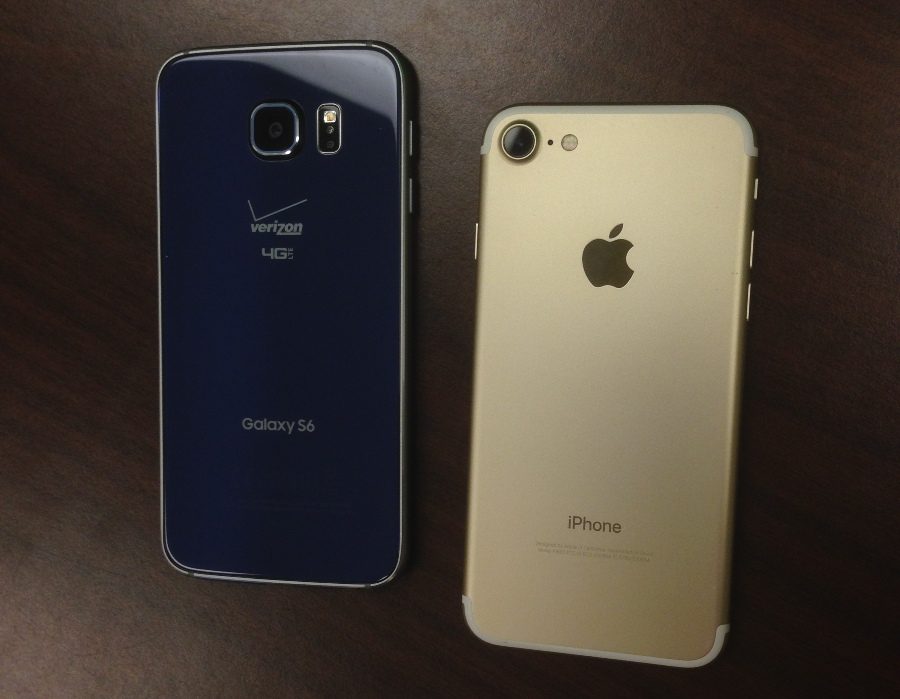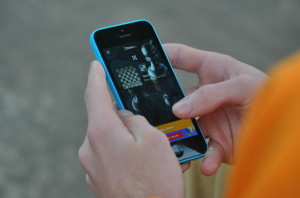Your call: Android or Apple?
The Apple iPhone (right) and Android (left) are two of the most popular smartphones among students at Starr’s Mill. The iPhone has seen a total of 12 versions, including ‘s’, ‘c’ and ‘plus’ categories. The iPhone seven made its debut on Sept. 7, 2016 and senior Richard Smith couldn’t have been happier. “I love my phone,” Smith said.
October 13, 2016
Throughout this technology-dependent day and age, smart phones have become an essential part of this world, with no signs of slowing down. The dire necessity of a phone isn’t short lived by the students at the Mill. Although they know that smartphones are an essential, it boils down to which one to have, the iPhone or Android?
For some, the answer lies in what students use the device for. Sophomore Erin Pham prefers Apple’s iPhone mainly because “the camera quality is good.” This is important because “ I’m in yearbook, and if I don’t have a professional camera, then it is good to have a [backup] to take good quality pictures,” Pham said.
Another iPhone advocate, freshman Courtney Devilla said that “the iPhone is better. More people have it, making it easier to communicate.” Although it may seem that the iPhone has a dominant take in the smartphone world, in reality, the popularity of the Android and iPhone is neck and neck. According to The Verge.com, “we’re close to reaching mobile equilibrium.”
With most of her contact circle in possession of an iPhone, Devilla enjoys the simplicity of texting over wi-fi, a feature that is nonexistent for Android. When she is trying to contact someone who doesn’t have an iPhone “it’s a hassle to have to text [them] since you never know if the message sent or not,” Devilla said. Like Pham, Devilla also finds Android camera quality to be sub-par to that of the iPhone.
Even though both Devilla and Pham claim that iPhones have the better camera, they still deal with the “poor” camera quality of the Android through apps like Snapchat. Whenever an Android owner sends any type of media over Snapchat , the iPhone user receives a less clear, choppier, version of what was sent. “I have definitely had to deal with [frustrations] when using Snapchat. [The difference in quality] can be very annoying,” Devilla said.
Though it may seem one-sided, these “annoying” instances also exist for Android users trying to get in touch with people who have iPhones. As a former Android owner for four years, senior Kyara Gomez said that “in a group chat [where all other parties have iPhones], messaging was slow and you had to download messages in order to see them.”
Another critique that Gomez made for the iPhone would be to increase the number of tasks that it can perform. “Androids are way more powerful and can do more tasks, and the battery life is so much longer than an iPhone,” Gomez said.
With such a powerful battery, Gomez suspects that the battery energy could have been a contributor to why the Samsung Galaxy Note 7 Android phones started blowing up after their release for the public in mid-August. According to cnet.com, Samsung’s decision was to “recall every single one of the Galaxy Note 7 smartphones sold,” equating to 1 million of the 2.5 million manufactured. After Samsung halted all shipments and transactions of the Galaxy Note 7s, they collaborated with manufactures and cell phone carriers to exchange faulty phones with new ones. However, “as of October 10, as many as five of the supposedly safe replacement Note 7 phones have caught fire as well, and Samsung is asking all users to shut down their phones.”
This explosive issue has driven many potential customers and students at the Mill away from the Android. “Honestly, that helped my decision to make the switch from an Android to iPhone. I don’t want it to blow up on me one day,” Gomez said.
But before the Samsung phones with Android software began blowing up, a large portion of students would agree that a pre-existing stigma of owning an android phone existed. “Androids are looked down upon [and] I think [owning one] became a negative because everyone who is anyone, like a celebrity, people at school, and doctors, all own iPhones. I guess it’s a bandwagon effect,” Gomez said.
Pham expressed similar thoughts on the Android ownership stigma. “I feel like the stigma exists because it’s not the norm [here]. And most, but not all, people usually stick to the status quo, so they make it a big a deal when someone has something different,” Pham said.
Although the iPhone doesn’t carry a stigma to most students, it is possible. When looking at the number of students with shattered iPhone screens in the hallway, a passerby could challenge the quality of the glass used to make the iPhone screen. Oftentimes, student iPhone users find themselves in a cycle where they receive a new phone, the screen shatters, they pay to get it fixed, and pretty soon the new iPhone comes out ready to be purchased and the cycle begins all over again. “I know seven people that fit the cycle perfectly,” Pham said.
In keeping with the Apple ‘smash and dash’ cycle, it appears as though stores across the U.S. rotate their products to accommodate the newest iPhone. Students are able to dash out to purchase the latest protective iPhone case to prevent another smash.
“The world seems more programmed to Apple products. Even on commercials for apps [the narrator] always says ‘available on the App Store’ first, and then ‘and on Google Play’,” Devilla said.
Another aspect that has Devilla convinced that the technological world gears itself more toward the iPhone is that “on TV, the characters always have iPhones instead of Androids.”
As the characters change on TV and new actors make their way onto the screen, the type of phones they hold will reflect just how far the technological world has come. If the iPhone and Android remain at the top of the hierarchy, what developments should we expect in smartphone technology?
Senior Austin Humphrey predicts that that “the evolution of both phones will continue to shrink until both Androids and iPhones will be the same each year.”
As a clear iPhone supporter, Devilla expects the iPhone to continue progressing. “The things that can be added to the iPhone are endless. [Apple] has already done a lot, and with the world of technology expanding rapidly around us, I think it will progress with no boundaries,” Devilla said.








